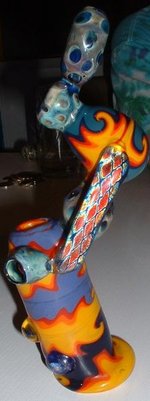Glassblowing
|
|
Glassblowing is the process of forming glass into useful shapes while the glass is in a molten, semi-liquid state.
History
While the first evidence of man-made glass occurs in Mesopotamia in the Late-Third/Early-Second Millennium BCE, the actual "blowing" of glass using a tube did not occur until sometime between 27 BC and AD 14 in Syria. This advancement transformed the material's usefulness from a time-consuming process in which the medium was hot-formed around rough cores of mud and dung into a mass-producible material which could be quickly inflated into large, leakproof vessels. Glassblowing techniques spread throughout the Roman world. Venice, particularly the island of Murano, became a centre for high quality glass manufacture in the late medieval period.
Process
Traditionally, the glass was melted in furnaces from the raw ingredients of sand, limestone, soda, potash and other compounds. The transformation of raw materials into glass takes place well above 2000°F (1400 K); the glass is then left to "fine out" (allowing the bubbles to rise out of the mass), and then the working temperature is reduced in the furnace to around 2000°F. "Soda-lime" glass remains somewhat plastic and workable, however, as low as 1000°F.
A lampworker, usually operating on a much smaller scale, historically used alcohol lamps and breath or bellows-driven air to create a hot flame at a workbench to manipulate preformed glass rods and tubes. These stock materials took form as laboratory glass, beads, and durable scientific "specimens" — miniature glass sculpture. The craft is still practiced today; the modern lampworker uses a flame of oxygen and propane. The modern torch permits working both the soft glass from the furnace worker and the borosilicate glass (low-expansion) of the scientific glassblower who may have multiple headed torches and special lathes to help form the glass or fused quartz used for special projects.
External links
- Glassblowing information (http://www.glassblower.info/)
- A Brief History of Glass (http://www.glassonline.com/infoserv/history.html)nl:Glasblazen


